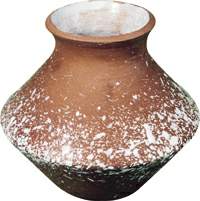Work by ceramist Julia K. Horová
Ester Plicková
The name of academic sculptor Julia Horová-Kováčiková has remained alive in the minds of artists, museum curators, ethnographers and wider intellectual cultural circles, especially her creative presence in the traditional ceramic centre of Pozdišovce in Eastern Slovakia. When she came here for the first time in June 1946 on behalf of an appointment by the Centre for Folk and Art Production, she found a society with more than fifty excellent ceramic makers. However, time has changed significantly and the current craft mastery of ceramic producers at that time was old-fashioned in several respects but in others was a source of the continuation of well-known production and artistic values. How should we progress and orientate? – that was the impulse given by Julia Horová. She studied sculpture at the Art and Industrial School in Prague. During her studies, she completed production practice in the Slovak Ceramics Factory in Modra, while in 1928 she entered the Slovak Artistic Association and successfully participated in their membership exhibitions. A stay in the Parisian studio of Lachenalle widened and enriched the horizons of her artistic thinking and feeling, as well as the scholarship time spent in 1930 to 1931 at L’institut de Céramique français de Sevres. The brilliant harmony of craft with art has remained a permanent character of the personal expression of Julia Horová. In the period 1931 to 1939, she taught at the avant-garde School of Art Crafts in Bratislava. The scale of her artistic potential oscillates from large-scale figural creations in concept viewed by a sculptor to collections with a mainly utilitarian focus. These are vases, bowls, plates, jugs, candleholders, small figural sculptures – mainly with animal themes, and various interior accessories of a chamber character. These artefacts are only rarely modelled in her hands. The majority are made on the wheel with reminders of shapes taken from traditional folk Slovak, Czech as well as universally traditional ceramic. In addition, traditional ceramic elements decorate the surface. Spoon decoration, for example, has a special genesis. The author successfully uses the potential of the technique in her compositional intention. Sometimes she places plastic abstract colourful groups with a spoon, other times she jots down large-scale pictures with stylistic, mainly vegetative motifs. At the same time, Julia Horová also provided a rich inspiration to many ceramists. She left the most remarkable prints in Pozdišovce. Within ÚĽUV she introduced beneficial and inevitable technical improvements and designed some actual changes in the variety of production. The most successful were the decorative motif of the Zemplín female circular dance called “karička”. Nearly all Pozdišovce ceramists have used this motif. Julia Horová has also worked in other significant ceramic centres (Bardejov, Držkovce, Ľubietová, Nová Baňa, Prešov, Pukanec, Šivetice). She created a reliable theoretical and methodological base for ÚĽUV as well as pragmatic bases followed by many other artists.
